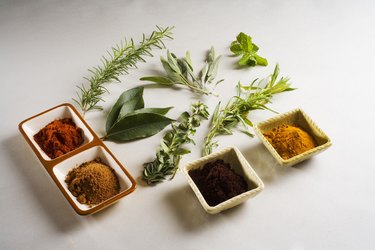
A high-sodium diet upsets the fluid and electrolyte balance in your body, raising your risk of developing high blood pressure and heart disease. Even if you make an effort to choose fresh and unprocessed foods at the grocery store, the seasonings you use in your recipes may cause you to exceed your daily sodium recommendations.
Sodium in Table Salt
Video of the Day
Table salt adds flavor to a wide variety of foods, from homemade baked goods to canned soups in the supermarket. One teaspoon of table salt contains 2,325 milligrams of sodium, more than the Institute of Medicine's daily recommended maximum of 2,300 milligrams a day. The Centers for Disease Control and Prevention reports that Americans consume more sodium now than they did in the 1970s, but the salt shaker on the kitchen table is not the main offender. Most of the salt in the current American diet comes from restaurant and processed foods.
Video of the Day
Sodium in Seasoning Salts
If you use a seasoning salt, such as onion or garlic salt, you may consume more sodium than you should during your meal. According to Texas A&M Agrilife Extension, garlic salt contains 1,850 milligrams of sodium per teaspoon, and onion salt has 1,620 milligrams. Cut down on the sodium in your recipe by using fresh, minced or powdered versions of these flavorful vegetables instead. One clove of fresh garlic contains 1 milligram of sodium, and an entire cup of chopped onions adds only 6 milligrams of sodium to your dish.
Sodium in Mixed Seasonings
Mixed seasonings, such as chili or pizza seasoning, are convenient, but their sodium content varies. Pumpkin pie spice, a blend of allspice, ginger, nutmeg, cinnamon and cloves, provides only 1 milligram of sodium per teaspoon. Other mixed seasonings contain a significant amount of sodium. The U.S. Department of Agriculture's National Nutrient Database reports that 1 teaspoon of chili seasoning mix contains more than 300 milligrams of sodium, 13 percent of the daily recommended limit. Check the sodium content of all mixed seasonings before purchasing, and choose low-sodium or sodium-free varieties when possible.
Low-Sodium Herbs and Spices
Fresh herbs and dried spices contain a minimal amount of sodium, so use these healthy seasonings to flavor your meal. Experiment with low-sodium seasonings such as basil, oregano, cumin, turmeric, chili powder and cilantro in your recipes. One tablespoon of ground thyme contains only 2 milligrams of sodium and adds a powerful and savory flavor to lean meats, whole-grain side dishes and mixed vegetables. If you prefer spicy foods, paprika provides only 2 milligrams of sodium per teaspoon.
- Institute of Medicine: Dietary Reference Intakes: Water, Potassium, Sodium, Chloride, and Sulfate
- USDA National Nutrient Database: Salt, Table
- Centers for Disease Control and Prevention: Americans Consume Too Much Sodium (Salt)
- Texas A&M Agrilife Extension: Sodium Content of Foods
- USDA National Nutrient Database: Garlic, Raw
- USDA National Nutrient Database: Onions, Raw
- USDA National Nutrient Database: Seasoning Mix, Dry, Chili, Original
- USDA National Nutrient Database: Spices, Pumpkin Pie Spice
- USDA National Nutrient Database: Spices, Thyme, Dried
- USDA National Nutrient Database: Spices, Paprika